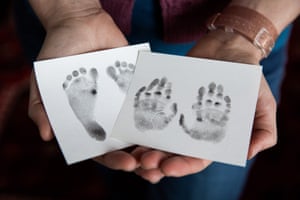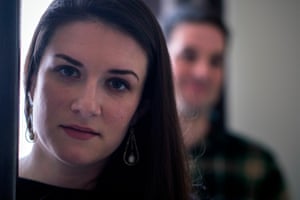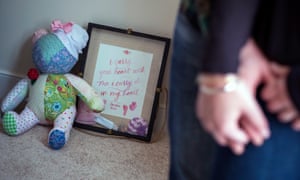Last year, Donald Trump suggested that current abortion laws allowed doctors to “rip the baby out of the womb of the mother just prior to the birth of the baby”. His statement erroneously described abortion procedures, and also triggered an uproar among the women and men who know firsthand the devastation of ending a late-term pregnancy.
Nearly 99% of abortions occur before 21 weeks, according to the Center for Disease Control and Prevention, but when needed pass that point it is in response to harrowing circumstances.
“Abortions that occur at this stage in pregnancy are often the result of tragic diagnoses and are exactly the scenarios wherein patients need their doctors, and not obstructive politicians,” says Dr Jennifer Conti, clinical assistant professor at Stanford University. “Asking a woman to carry a fatally flawed pregnancy to term is, at the very least, heartbreaking. I’ve often heard women say that they chose to end such pregnancies because of unselfish reasons: they couldn’t bare the thought of putting their fetus through even more pain or suffering.”
Just this year, 400 abortion restrictions were introduced in 41 states, according to the Guttmacher Institute, a research organization that supports abortion rights. Among them, Republicans introduced the first ever federal “heartbeat” bill earlier this year – which would ban abortions after a heartbeat is detected. Meanwhile, Congress is considering a bill that would also ban abortion at 20 weeks nationwide – which is when ultrasounds can offer the first signs of fetus anatomy anomalies.
Here, three different women agreed to share their experiences to end misconceptions about late-term terminations, and to explain to politicians and the general public why they’re necessary in the first place.
Kate Carson, teacher, outside of Boston, Massachusetts
That warm June day, the recovery room was silent. The doctor entered carrying Laurel, a bundle of just five pounds wrapped in a pink-and blue striped cotton blanket. He gently passed her to her mother, Kate. She bent forward to smell her. She touched her skin. Her daughter was warm, but not as warm as she should have been.
“I just needed to know it happened. I needed to know that I had a baby,” Kate Carson says.
At 27, Kate had her life planned out. She and her husband were going to have four kids, and she was going to be an engineering professor. Her first pregnancy went fine, and she had a healthy baby girl. But while pursuing her PhD in engineering, she suffered three miscarriages. “It was a long road,” she says, but at by 29, she was finally expecting another girl, Laurel. She was due in the summer of 2012, and both parents were elated.

At 19 weeks, an ultrasound revealed a shadow of concern but the finding was reversed with full confidence at a level two ultrasound. “I’m not seeing any problems. Everything looks fine,” the specialist told the parents.
But Kate had a nagging worry. “My husband and I did not feel like everything was fine,” she says. She asked the nurse how sure the specialist was. “He would have to be so certain. They would never reverse a diagnosis without being super sure about it,” the nurse replied.
Yet her husband encouraged her to book another second level two ultrasound, a “piece of mind ultrasound”.
Expecting only reassurance, Kate knitted a pink sweater for Laurel while chatting freely with the technician who quickly grew silent. There was a big black spot on Laurel’s brain. “This baby is different,” the technician said. She left the room and returned with a maternal fetal specialist and a specialist in training.
“That’s when they started telling me,” Kate says. The fetus had Dandy-Walker malformation, a set of abnormalities of the cerebellum.
“The problems we didn’t see last time, we are seeing today,” said the specialist. She offered Kate adoption and abortion, “if it was still a legal option”. They used to send women to Kansas for abortions, she told her, but that was before Dr Tiller was shot in the face at a Sunday church service.
Kate asked if children with Dandy-Walker malformation are ever normal. “Yes,” said the specialist.
“And that, honestly, is so hard to hear because you just want something definitive”, Kate recalls. “On the one hand, of course you want your child to be normal. On the other hand, you want to know, is your kid going to be okay, is your kid going to receive a devastating diagnosis?” But the specialist had no definitive answers and recommended an MRI to determine whether Laurel would be okay or “incompatible with life”.
Kate couldn’t get the MRI for the next 48 hours. The wait was excruciating. At home, she could find no peace and substituted knitting her baby’s sweater for sleeping. She curled up on her living room sofa and cried until her husband scooped her up each night and took her to bed.
“When you’re imagining futures beyond the miracle happy ending, it’s sinking in,” she says.
The day of the MRI finally arrived. She was 35 weeks, 0 days. By the end of it, Kate and her husband had the hardest answers they’ve ever received.
Their daughter had moderate to severe Dandy-Walker malformation. But that wasn’t the only diagnosis; Laurel also had a brain condition in which fluid builds up in the ventricles, eventually developing into hydrocephalus and possibly crushing her brain. She had a congenital disorder too, in which there was complete or partial absence of the broad band of nerve fibers joining the two hemispheres of the brain.
What this meant was Laurel was expected to never walk, talk, or swallow. That was if she survived birth.
Kate asked her doctor, “What can a baby like mine do? Sleep all the time?”
“Babies like yours are not generally comfortable enough to sleep,” the neurologist said.
“That is when it became very clear what I wanted to do,” she says. “The MRI really ruled out the possibility of good health for my baby.”

For Kate, giving a child life and peace are the two gifts a mother can offer. “Most babies get to have life and get to have peace, but this baby, I had to choose. I could choose life, with the outside chance of peace or occasional peace, or I could choose certain peace without life. And for me, certain peace without life was the choice I wanted to make.”
On their ride home, Kate and her husband were silent as they drove in rush hour traffic across the Zakim Bridge. Unable to say it herself, Kate’s husband uttered the word abortion. “I think we should ask about it,” he said.
“I had been in this dark, awful prison of a place inside myself,” she says. Her husband’s words comforted her.
When they arrived home, Kate immediately called the doctor and left her a message. Her mother arrived to pick up their daughter and before leaving said she would have done the same. An hour later, the phone rang. Kate grabbed it. If they wanted the abortion, they had 30 minutes to call a clinic in Colorado before closing time or wait the weekend. The procedure would last four days. And they would need $ 20,000. Massachusetts doesn’t allow abortion after 24 weeks unless it’s necessary to save the life of the mother.
Kate and her husband live a modest life, certainly not one with $ 20,000 readily available. Kate’s younger brother offered his life savings of $ 5,000, but it was her parents who gave them the money from their retirement fund. “This is exactly why these abortions exists,” said her father.
Three days later, they were driving up to Dr Hern’s Boulder Abortion Clinic, where surveillance cameras and razor wired fences surrounded them. She was 36 weeks.
I felt like the only one in the entire world … but we are not entirely alone. Just hidden
Inside the clinic, Kate took a blood test followed by exhaustive counseling sessions, then the consent form. Dr Hern wanted to make sure she was doing this of her own free will.
By the end of the day, Kate and her husband knew it was time. Dr Hern took Kate to a room for the injection. It would slow her baby’s heart to a stop as soon as it penetrated. Sometimes, it happens quickly. For Kate, it happened over the course of a couple of hours. Just as she and her husband were planning to grab a bite of food, Laurel kicked. “I lost it,” says Kate. She retreated to her hotel room and lay there until the moving stopped. When Laurel went still, Kate’s stomach sagged low and lifeless, she says. “It was really sad and really hard.”
“I did not ever doubt I was doing the right thing for her but that did not make it easier,” she says. Kate says Laurel got the “tightest hug”. Her body was hugging her.
Next, it was time to get dilated, which was painful for Kate because she couldn’t receive an epidural. On the last day in Colorado, on an early June day, Kate, who was in labor for two and a half hours, delivered Laurel.
In the recovery room, Dr Hern brought Laurel to her. She smelled right, she felt warm, but not as warm as a live baby.
“She was beautiful,” Kate says.
When Kate returned home, they scattered Laurel’s ashes in the ocean. It was time for closure, but Kate worried about judgment so she didn’t tell anyone what happened for months. Then the self-doubt came.
“I feel like myself got fragmented into a million different selves. And I had my angry guard dog piece and my jealous piece, had my sad piece, I had the guilt, the religious piece. All of these pieces, and I had to figure out who I was”.
For some time, Kate wondered about the human error piece in the equation and wondered if her first doctor might have mislead her on purpose. A little research later proved it was just an honest mistake. “I can live in a world where people make mistakes,” she says. “I felt like the only one in the entire world who had had such a later abortion and it is true that we are rare, but we are not entirely alone. Just hidden.”
Since Laurel, Kate gave birth to another healthy daughter.
Kate Carson speaks about her experience to doctors, lawyers, and neighbors. You can also read about her experience here
Lindsey Paradiso, wedding photographer, Virginia

The moment Lindsey, 27, found out she was pregnant, she wrapped the positive test strip in a used gold metallic gift bag and surprised her husband, Matt, with it. Two months later, they named her Omara Rose.
This was not the easiest pregnancy for Lindsey. She suffered from sciatica nerve pain and had to undergo daily injections for her blood clotting disorder. But she was over the moon about the pregnancy.
At first, it looked like a bubble floating on the ultrasound. At the routine 18-week visit in February 2016, the doctor speculated the peculiarity could be cystic lymphangioma, a group of cysts found mostly in the neck. Or it could be nothing. They immediately booked an appointment with the University of Virginia (UVA).
After seeing the ultrasound at UVA, Lindsey noticed the growth had enveloped half of Omara’s face and spread around her neck to the back of her head. When the doctor entered, they expected the worst. Again, the term lymphangioma came up. But so did cervical teratoma. Only an MRI could determine decisively, but whether it was malignant or benign, it could be fatal to the baby.
“You could just tell the energy in the room was like you should end it, it’s not going to turn out well,” she says. The doctor told them they could terminate the pregnancy since Omara’s chances of survival were slim. Matt and Lindsey were crushed by the prospect. They wanted to fight.
Twenty days after seeing the first signs of trouble, they learned that Omara had an aggressive form of lymphangioma growing out of her neck. The diagnosis came in the form of a dense two-page MRI report. The fast-growing, inoperable tumor had grown into her brain, heart, and lungs. It had wrapped around her neck, eyes, and deep into her chest. It was so invasive, it was pushing her tongue out of her mouth.
Her chances of living to age of viability or birth were slim. Lindsey and Matt made the heartbreaking decision to follow through with an abortion at around 24 weeks. They were just a few days away from it being an illegal termination.

On 26 February 2016, Omara Rose’s heart stopped beating. Shortly after, Lindsey was admitted into the hospital for labor induction but the epidural stopped working. “I felt like my insides were being ripped apart,” she says. When the doctor administered a second epidural, Lindsey became nauseous. Her ears rang. The room spun. The doctor rushed in to administer a third epidural.
She was conflicted the whole time because while she was in pain, she didn’t want it to stop because she knew by the end of it “your child is going to be dead”, she says. Matt held her hand the whole time.
To hide something because you’re ashamed of it is just going to perpetuate misunderstanding
When she finally delivered Omara Rose 40 hours later, she was so small, “I barely felt her leave me but I knew she had,” she says.
Over the next few hours, Lindsey and Matt got to hold Omara Rose, dressed in a tiny dress with a hat the size of the cup of Lindsey’s hand. Then Lindsey’s and Matt’s family came, each taking turns to say their goodbyes. “I wanted her to be alive so badly but I knew it was for the best. She went without pain,” she says.
The next day, they buried their daughter in a cemetery four hours away from where they live now.
“I don’t think people understand the gravity of how sick she was. How fatal her tumor was,” says Lindsey.
But it took some time for them to be open about it, especially Matt. Lindsey found comfort in blogging while Matt focused on completing his education at Virginia Tech.
“To hide something because you’re ashamed of it is just going to continue to perpetuate misunderstanding,” says Lindsey. People automatically assumed that if she had the abortion, it was out of convenience. On the contrary, she says. “It’s something that will stick with you forever.”
For those who believe these babies are unwanted, Matt says: “You’re not going to wait until halfway through your pregnancy to finally have an abortion.”
Prompted by Donald Trump’s statements on late-term abortions, Lindsey shared more widely her experience in a Facebook post, which was shared over 100,000 times.
“Abortions are hard decisions made by real people,” she says. “Being open is a call for empathy.”
Lindsey Paradiso testifies against bills to limit access to safe and legal abortions. She’s also blogged about her experience here
Darla Barar, Austin, Texas, copyrighter

On 22 June, at 3.30pm, the doctor let them see Cate one last time. She danced for them and then kicked. Her mom told her it was going to be okay. And then, guided by the ultrasound, the doctor injected a medication into Cate’s heart, stopping it. When they checked for a heartbeat 30 minutes later, the silence was deafening.
Darla, then 29, and her husband Peter had tried for years to get pregnant. When treatments failed, they traveled to the Czech Republic to use donated eggs. A week after the transfer, Peter got a dinner dessert with a message: “Congratulations daddy.” They were expecting twins.
Darla and Peter had named their twins Catherine “Cate” and Olivia, and by their 20-week anatomy scan they already knew their distinct personalities. Olivia was a “diva” and Cate was shy, a “cuddle bug”. “We loved them more fiercely than I ever thought possible,” Darla says.
But during a routine anatomy scan, the technician was abnormally quiet. Cate was measuring a little behind but she was always the smaller of the two, so Darla didn’t worry much. After a long wait, the OBGYN entered the room and asked Darla to sit next to her husband. “I just knew something was wrong,” Darla says.
Finally, we just looked at each other and said it was okay. We had to do what was best for her
Darla recalls hearing the doctor say he had never seen this combination of anomalies before.
Darla and Peter saw additional specialists, and all confirmed a number of issues. Cate had encephalocele, which is a neural defect that causes brain matter to leak out, slow growth, microcephaly, a very large cleft lip and possible fused digits. Her cerebellum was so underdeveloped that one doctor had trouble finding it and her brain’s midline was shifted, indicating “severe disorganization”.
To make matters worse, Olivia’s life was in danger. Cate’s amniotic sac was growing and restricting the growth of Olivia’s sac.
If she carried to full term, the restriction on Olivia’s sac would likely mean an early delivery. Darla says that every specialist they saw disclosed there was a high probability that Cate would not survive the delivery but if she did, there was no guarantee the surgeries – removing the encephalocele and placing her brain tissue back into her skull – would save her.
Darla cried and Peter prayed. “We needed a miracle and we knew as the day went on we weren’t going to get one.”

Their other option was abortion, one they did not take lightly, but one that felt rushed because of Texas’ restrictive abortion laws, which bans abortions after 22 weeks. Darla and Peter had 12 days to decide. “If laws were different … we would have done more testing – one doctor mentioned an MRI, for example, to try to test the level of her brain function. But we didn’t have that, and knowing what timeline we were on, we spent a lot of sleepless nights researching, making appointments, talking to each other and our therapist, and really just spending time being the four of us,” she says.
“Finally, we just looked at each other and said it was okay. We had to do what was best for her. So we knew what we had to do to bring home one”. Darla says she was prepared to deal with it all, but “if it meant Cate was going to suffer, we just couldn’t do that to her.”
At 21 weeks and 6 days, Darla had an injection, and Cate’s heart stopped. “For us, it was completely humane,” she says.
In the case of an additional fetus that gets aborted in the womb, the tissue is usually reabsorbed back into the body, but that wasn’t the case this time.
“I kept telling Peter, I’m carrying our healthy baby and our dead baby. I can’t reconcile that in my brain. At the same time, it was a comfort to know that I didn’t have to say goodbye right then,” she says.
Thirteen weeks after the diagnosis, Darla delivered Cate and then gave birth to Olivia, a healthy five-pound baby. The family took turns holding Cate and later in the afternoon, the chaplain came to take her away.
“And then we had to grasp that we were only a family of three,” she says.
Darla says she couldn’t face people after the abortion. She called it a stillbirth. “I knew I was dealing with more than just grief and I couldn’t explain that to people,” she says. She was also dealing with guilt. But she never felt regret, she says. She knew she did the right thing.
Spurred on by Donald Trump’s comments about later abortions, Darla took to social media to share her story and the response was overwhelming, both good and bad. The meaner comments focused on abortions as a version of birth control, or a way to rid oneself of an imperfect child.
“I can tell you, knowing how much the procedure cost, nobody is doing that for birth control,” she says. “Ask us why we’re getting it. Don’t assume that you understand our lives.”
Nonetheless, “being open has allowed me to be a better mom. I’m much more free with my emotions,” she says. Knowing that she could become a voice for women and men who needed it empowered her.
“It’s always the health of the mother but the health of the baby is never taken into consideration [into laws] and in situations like ours, it could have meant two dead babies on our hands,” she says.
Darla Barar blogs about her experiences here
The agony of ending a wanted late-term pregnancy: three women speak out
Hiç yorum yok:
Yorum Gönder